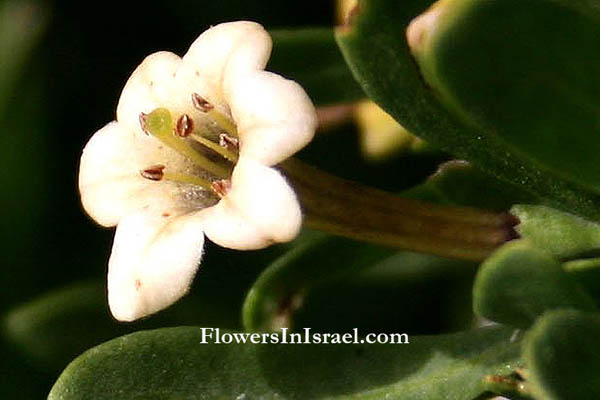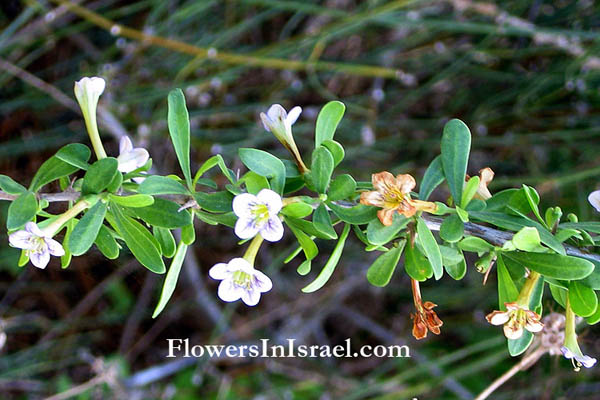Boxthorn, European matrimony-vine, European tea tree,
Hebrew: אטד אירופי, Arabic: عوسج
| Scientific name: | Lycium europaeum L. | |
| Synonym name: | Lycium intricatum Boiss., Lycium mediterraneum Dunal | |
| Common name: | Boxthorn, European matrimony-vine, European tea tree | |
| Hebrew name: | אטד אירופי | |
| Arabic name: | عوسج, Awsay | |
| Family: | Solanaceae, סולניים |

|
| Life form: | Shrub | |
| Spinescence: | Stems | |
| Stems: | 2-3 m tall, spreading about 3 m across; young light brown, hairless stems (i.e. glabrous), much-branched, turn grey or brown and fissured as they mature; spines up to 15 cm long on older stems, much smaller spines on newer growth (about 2 cm long); each small side-branch ends in a small spine | |
| Leaves: | Alternate, entire, lanceolate leaves 2 to 5 cm long | |
| Inflorescence: | Flowers solitary or sometimes geminate, on a short stalk, erect and sweet-scented | |
| Flowers: | Pink, greenish-yellow tubular flowers | |
| Fruits / pods: | Berry about 8mm in diameter; a yellow berry once known as "Lot's lemon" | |
| Flowering Period: | June, July, August, September | |
| Habitat: | Mediterranean maquis and forest, Shrub-steppes | |
| Distribution: | Mediterranean Woodlands and Shrublands, Semi-steppe shrublands, Shrub-steppes, Deserts and extreme deserts | |
| Chorotype: | Mediterranean | |
| Summer shedding: | Perennating |

Derivation of the botanical name: Lycium, from Lycia, an ancient country in Asia Minor, and / or from the Greek name Lykion used by Dioscorides and Pliny for some thorny tree or shrub. europaeum, European. intricatum, tangled. mediterraneum, Mediterranean. The Hebrew name: אטד, atad, related to Aramaic-Syrian: אטדא, atda, Arabic: 'atad, Akkadian: etidu and ittitti.
Michael Zohary (1898 - 1983), in 'Plants of the Bible', gives reasons that Azekah is a place name in Judea at the foot of the western mountains, named for the abundant boxthorns there, noting that giving plant names to places is common in the Bible; names for acacia, olive, oak, pistachio, pomegranate, and willow often appear as place names. The name Azeka is from the same source as the Arabic ausseg. Michael Zohary identifies atâd (Greek, ράμνος) used in Jotham's Parable (Judges 9: 7-21), as Ziziphus spina-christi. In the Bible we can find Azekah seven times. Bible resources:
|